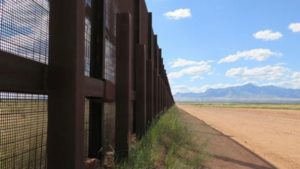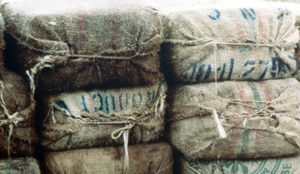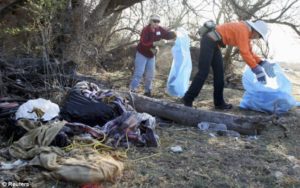After reading my blog post about drug smugglers on public lands more than one person said the solution is: Build The Wall.
I don’t think so. For one thing, the rancher who was slaughtered by drug runners in 2010 (near Douglas, AZ) had a property that was bordered by a wall, which never stopped smugglers from coming through. Shortly after his death, NPR spoke with a neighbor of the slain rancher who also lived along the wall. They reported:
“The border fence is visible from his kitchen window. It was built a couple of years ago to keep people out. Ladd says the Border Patrol doesn’t keep a constant presence next to the fence, so people climb it using ladders, screwdrivers stuck into the fence mesh, even Mexican ponchos, or serapes, thrown on top of the fence.
Ladd says he has counted 47 groups crossing onto his land in just the past three weeks — more than 300 people.”
The idea of a wall keeping out smugglers is a sham. Smugglers have already learned how to breach a wall from all directions: straight through, over the top, underground. Besides, we already have an agency – The U.S. Border Patrol – that has the mandate, manpower, technology, and other resources to stop the encroachment of smugglers into our country and onto our National Forest lands. It is all a matter of strategy and priorities.
One strategic nightmare that affects rural areas is the focus on more populated areas. While I applaud the effort to focus on ANY drug cartel violence, the priority given to populated areas has forced drug runners deeper into rural areas, including onto our public lands. Rural Cochise County, home of the Chiricahua Mountains where I wandered the other day, is a hot spot. In an interview with NBC, Cochise County Sheriff Mark Dannels argued:
The biggest cause of his county’s problems, ironically, is the federal government’s plan in the 1990’s to greatly strengthen security measures for the U.S. ports of entry and the southwest border cities, including San Diego, Yuma and El Paso. In those highly populated areas, authorities erected tall, layered steel fences; placed surveillance cameras and assigned increased numbers of U.S. Border Patrol and Customs agents.
Dannels conceded the border cities have greatly benefited from the plan and enjoy much lower crime rates than in the past. But, an unfortunate consequence, he claimed, is that Mexican smugglers have been funneled now into the rural areas along the border that are much less protected, including parts of Cochise County, which shares an 85-mile-long border with Mexico.
From my perspective, it seems that the thinking is whew, let them run amuck out there in the backcountry, away from our cities. However, out there is where I hang out, enjoying the wildlife and fresh air. Think I am paranoid about my government? An article in Newsmax suggests otherwise. Normally I would not quote anything from the Fox News machine, but they zoom in on the drug smuggling problem on public lands in Arizona and we seem to agree on one issue: ceding any public lands to drug cartels in unacceptable.
Another problem that reduces Border Patrol effectiveness in rural areas: while they look well-trained and ready for the fight, they tend to avoid situations where they would take fire. I understand that and mourn with everyone down here the recent killing of a Border Patrol Agent. However, to clean out our public lands, where drug scouts hang out in caves and are difficult to find, we need agents trained in combat situations. We need something like a Border Patrol Special Forces, a band of fearless people who will go in and get the bad guys. Like the guys in the Yuma Sector who showed this past January that they are not afraid of and who know how to take down drug smugglers. Border Patrol has the technology, funding, and manpower. The issue for me is not can we run drug thugs from our public and private rural land but when will it become a priority to provide proper training?
Rather than a steady focus on manpower and training, a controversial strategy that continues as a high priority is reducing the demand for illegal drugs (see government publication, National Southwest Border Counternarcotics Strategy). Good luck with that. The great drug war has been waged and lost my entire life. In fact, Big Pharma, who is in bed with FDA, has enabled our national drug problem via opioids.
But, I don’t want to lump together the transport of opioids and marijuana in this essay about taking back our public lands. Narcotics, which take up far less space, tend to come through the established border stations in private and commercial vehicles. A 2017 report by NBC news elaborates on that matter. Marijuana is coming through on my hiking trails and the smugglers take breaks in my campgrounds. Drug cartels coerce sturdy Mexican men to haul on their back the bulky bales of marijuana. Human mule trains in the dark night, flanked by armed scouts in the front and back of these processions over rancher-owned and public lands. By the way, how do we know about the presence of marijuana-hauling mules? Some get caught. But the overwhelming evidence of the passage of smugglers and illegal immigrants is the trash they leave behind. That’s right, my hiking trails are no longer safe for me to traverse AND my backcountry is turning into a trash heap. On some levels, this ticks me off even more. Reuters and others have documented the related trash problem.
Hey! How about legalizing marijuana as a strategy? The Washington Post reported in 2016, “ Legal marijuana may be doing at least one thing that a decades-long drug war couldn’t: taking a bite out of Mexican drug cartels’ profits. The latest data from the U.S. Border Patrol shows that last year, marijuana seizures along the southwest border tumbled to their lowest level in at least a decade. Agents snagged roughly 1.5 million pounds of marijuana at the border, down from a peak of nearly 4 million pounds in 2009. You can read the rest of this article here.
So why is building a wall so popular? Before spending outrageous sums on building a wall, which will be breached repeatedly and become an environmental disaster of unbelievable proportions, we need to further enable and train our Border Patrol and attack the problem across the entire border. If the Border Patrol is not getting the job done, fix it. Pour resources into increasing staff quality and their training, upping the priority of rural ranchers and public land.





